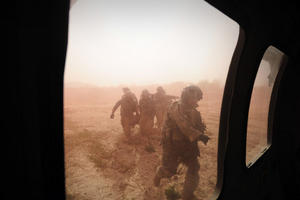In the trenchesBlast gauge gives medics, doctors critical information
Researchers are working to enhance the safety of soldiers in the field through the development of a device that monitors the physical impacts of exposure to an explosive blast; 188,270 service members have suffered a traumatic brain injury in the last decade; the extent of injury is often difficult to discern, making diagnosis and selection of appropriate medical treatment challenging

Wounded soldier being carried to helicopter // Source: armytimes.com
Traumatic brain injury is emerging as a significant challenge for veterans. The Rochester Institute of Technology assembled a response team that engineered a dosimeter device to monitor blast exposure, which in the future could assist with field triage to identify injury long before physical and cognitive symptoms arise.
According to the Defense and Veterans Brain Injury Center established by Congress, 188,270 service members have suffered a traumatic brain injury in the last decade. The extent of injury is often difficult to discern, making diagnosis and selection of appropriate medical treatment challenging.
When a solider is exposed to a blast, shockwaves can cause a series of complex mechanical and physical reactions in the brain. These blast waves can induce tissue strains and stress, which may result in brain damage. Currently, no experimental data for humans exists to correlate pressure and stress on the brain with an actual explosive event that could assist with predicting brain injury. A Rochester Institute of Technology release reports that through an effort funded by the Defense Advance Research Projects Agency (DARPA), a team of RIT engineers has responded to this urgent need by designing, engineering, and testing a blast measurement device that in the near future could be used to assist with field triage.
Dr. David Borkholder, associate professor of electrical and microelectronic engineering, assembled a project team consisting of Dr. Lynn Fuller, professor of electrical and microelectronic engineering; two senior engineers, Gary Parrett and Werner Fassler; a recent RIT engineering graduate, Matthew Waldron; and staff assistant JoEllyn Tufano.
Andrew Blair, an Army ROTC cadet; Stefan Wojick, a former U.S. Marine; Aalyia Shaukat; and Sigitas Rimkus, all undergraduate engineering students, are also involved in the project, participating in design work as well as system testing.
“While the core technology exists, the challenge is customizing the capabilities through creative engineering and integrating the components into a single system that provides a practical solution for the military,” Borkholder told the Engineer.
The device was recently tested in the field using propane and oxygen explosions and weighted crash-test dummies to simulate a soldier.
The research has resulted in the formation of a company, BlackBox Biometric, which plans to commercialize the device this year.
